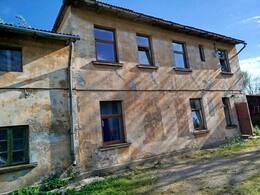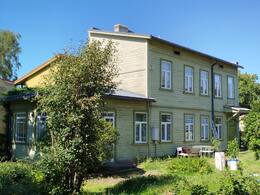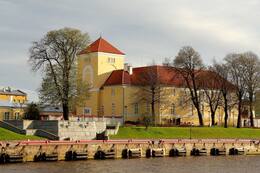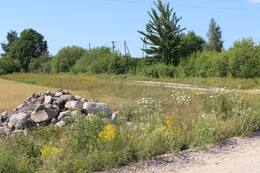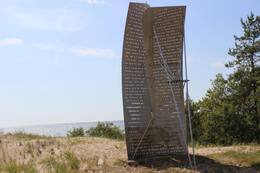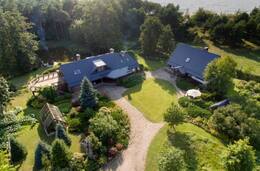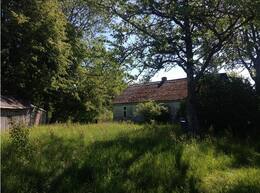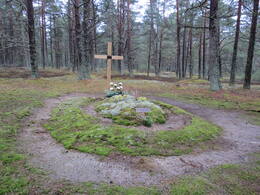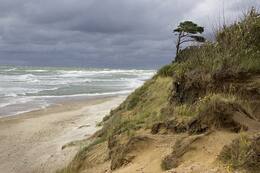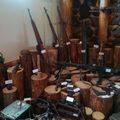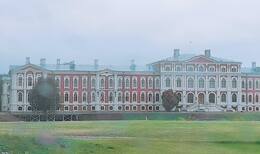Центральный совет Латвии (ЦСЛ)
II Вторая мировая война, III Национальное движение сопротивления, “лесные братья”, IV Советская оккупация
Läti poliitikute loodud illegaalne vastupanuliikumise organisatsioon iseseisva ja demokraatliku Läti riigi tegeliku suveräänsuse taastamiseks 1922. aasta põhiseaduse alusel; asutatud 13.08.1943. Riia, lõpetas tegevuse paguluses – Saksamaal 1950. aastal ja Rootsis 1951. aastal.
LKP poliitilises tegevuses on eriline koht 17. märtsi 1944. aasta memorandumil, millele on alla kirjutanud 188 Läti avaliku ja poliitika töötajat.
Teise maailmasõja lõpus toimus LCP korraldatud illegaalne Läti põgenikepaatide liikumine natside okupeeritud Läti ja Rootsi vahel.
Дополнительные источники информации
https://enciklopedija.lv/skirklis/171407-Latvijas-Centr%C4%81l%C4%81-padome
(angļu – Läti kesknõukogu, vācu – Zentralrat von Lettland, Lettische Zentralrat, prantsuse – Conseil Central de Lettonie, vene – Läti kesknõukogu)
Saistītās laikalīnijas
Saistītie objekti
Дом в Вентспилсе, где в 1944 году жила связная ЛКП Валентина Яунземе (Ласмане).
Дом на улице Лауку 4, Вентспилс, где жила и работала учительница Валентине Ласмане (род. Яунземе) (1916–2018), которая в 1944–1945 гг. работал связным LCP и членом Вентспилсской коммуникационной группы. Жил в Швеции после Второй мировой войны. Она собрала показания 130 беженцев с лодок в публикации «Через море 1944/1945». (Стокгольм, 1990), а историю собственной жизни В. Ласмане можно прочитать в книге «Ночь не только для сна» (Рига, 2020). В 2000 году она была награждена Орденом Трех Звезд. Умер в возрасте 102 лет в 2018 году в пригороде Стокгольма Тебия.
Здание в Вентспилсе, где в 1944-1945 гг. В 2010 году представитель ЛКП и организатор движения лодок с беженцами доктор проживал в Курземе. Вальдемарс Гинтерс
Дом на улице Катринес, 4, Вентспилс, где работал археолог Валдемар Эинтерс.
С октября 1944 года по 8 мая 1945 года представителем ЛКП в Курземе был археолог Вальдемарс Чинтерс (прозвища «Доктор», «Садовник») (1899–1979). Участник Освободительной войны Латвии, директор Государственного исторического музея и доцент Латвийского университета. Награжден орденом Лачплешской войны и орденом Трех звезд. Один из подписантов меморандума ЛКП от 17 марта 1944 года. Жил в Швеции после Второй мировой войны. С 1949 по 1979 год председатель правления Латвийского национального фонда.
Тюрьма в замке Ливонского ордена во время Второй мировой войны
1944-1945 гг. в тюрьме, устроенной в Лифляндском замке Оден. В 2016 году были задержаны несколько членов коммуникационной группы ЛКП Вентспилс и грузчики лодок с беженцами.
Дорога к домам «Гриниеку» в Варвеской волости
Дорога к дому «Гриниеку» в Варвеской волости, где в 1944 году располагалось одно из основных поселений лодочных беженцев на побережье Курземе.
Временное жилье беженцев «Варве хижины»
Варвесские «хижины», место в Вентспилсском уезде, служившее временным приютом для латвийских беженцев, ожидавших прибытия лодок с Готланда в 1944 году.
Памятный знак беженцам "Парус надежды" в Юркалне
Памятный знак "Парус надежды", посвященный беженцам Второй мировой войны, которые в 1944 и 1945 годах пересекли Балтийское море на лодках и добрались до острова Готланд в Швеции. Мемориал находится в Освалки на дюнах между морем и шоссе Вентспилс-Лиепая, рядом с остановкой общественного транспорта "Кайяс". Его создал скульптор Гиртс Бурвис, который воплотил его в виде паруса надежды, символизирующего память о латышских беженцах.
С осени 1944 года по весну 1945 года, опасаясь возобновления советской оккупации, но не желая эвакуироваться в разрушенную и находящуюся под угрозой Германию, некоторые жители Латвии пытались добраться по морю до ближайшей нейтральной страны - Швеции. Часть судов была организована Латвийским центральным советом при помощи западных союзников, в результате чего в Юркалнесской волости образовался один из крупнейших пунктов сосредоточения беженцев. Кроме лодок, организованных Латвийским центральным советом, через море переправлялись и другие лодки. По оценкам, около 5000 человек смогли пересечь море. Число погибших неизвестно, так как учет беженцев, покидающих Курземское побережье, не велся.
Плавание было опасным, поскольку беженцам угрожали немецкие патрули на побережье и в море, морские мины, советские самолеты и военные корабли, а также штормы, поскольку переправа часто осуществлялась на неприспособленных и перегруженных катерах и лодках без достаточного запаса топлива и продовольствия, морских карт и навигационных приборов. Отплытие из Латвии осуществлялось тайно. Местом назначения судов был остров Готланд, а путешествия чаще всего начинались на западном побережье Курляндии (от Юркалне до Готланда 90 морских миль или около 170 километров по полету ворона).
"Bambaļi" houses - one of the main places of accommodation for boat refugees
The restored "Bambaļi" houses in Ošvalki, Jūrkalne parish, were one of the main places of settlement for boat refugees on the coast of Kurzeme.
"Laukgaļi" house, writer Kārlis Skalbe's place of residence
"Laukgaļi" in Jūrkalne parish, the writer Kārlis Skalbe's place of residence in October-November 1944, while waiting for the refugee boat to Sweden.
Lithuanian soldiers' graves in Zaļkalns Forest
The memorial is located near the Pāvilosta beach lookout tower in the dunes. There are signs pointing to the memorial.
At the end of the Second World War, three Lithuanian police battalions, the 5th, 13th and 256th, were also deployed in Latvia, and after guard duty and fighting against Soviet partisans and the Red Army on the Eastern Front, from autumn 1944 they were involved in guarding the Baltic Sea coast in Kurzeme.
In October 1944, all three battalions, consisting of 32 officers and about 900 instructors and soldiers, were subordinated to the German 18th Army's 583rd Rear Guard Unit (Koruck 583). The unit was tasked with guarding the Kurzeme coast from Liepāja to Ventspils. All three Lithuanian battalions were deployed in the vicinity of Pavilosta. In December 1944, the 13th Battalion was transferred to the German 1st Army Corps at the Liepaja Lake.
One of the tasks of the Lithuanian coastguard, besides being ready to fight enemy landings and to report enemy ships, was to prevent Latvian refugee boats from sailing to the island of Gotland, 160 kilometres away, but the Lithuanian coastguard men did not prevent the refugee boats from leaving. However, news of the Lithuanian coastguard helping the Latvian refugees and the Lithuanians themselves preparing to cross the sea to Sweden also reached the Germans.
On 10 January 1945, the soldiers of the 1st Company of the 5th Lithuanian Police Battalion were rounded up. More than a week of interrogation and trial followed, which, as a warning to the others, decided to execute seven of the Lithuanian soldiers and to imprison 11 of their comrades in concentration camps in Germany. The execution of the seven Lithuanian soldiers (Sergeant Macijauski, the company commander; Juozas Sendrjuas, a soldier; Vladas Salickas, a soldier; Ionas Bašinskis, Krasauskas and two unknown others) took place on 21 January 1945 in the Zaļkalns Pines in Pavilosta.
In January 1945, the 5th Battalion was disbanded and the combat-ready soldiers were divided into the two remaining battalions, while the rest were formed into a separate sapper company. At the time of the surrender of Army Group Kurzeme in May 1945, two battalions (13th and 256th) were still in Kurzeme as a sapper company with a total of 900 soldiers who were taken prisoner by the Soviets.
The coast of Mazirbe, from where the refugee boat traffic to Sweden took place in 1944
The coast of Mazirbe was an important place in the Second World War, from where the traffic of refugee boats to Sweden took place in 1944.
Staldzene steep bank, from which refugee boats to Sweden were transported in 1944
In 1944, there was an active traffic of refugee boats to the shores of Sweden from Staldzene.
Museum of the National Resistance Movement in Renda
The museum is located a few kilometres from the centre of Renda parish. The exhibit tells about the 50-year-long resistance movement in Latvia: resistance to the first Soviet occupation, resistance to the Nazi German occupation, and the armed and non-violent resistance to the Soviet occupation. The exhibit is located in two buildings. The first building houses evidence of the first Soviet occupation and German occupation. The exhibit showcases a restored barn building where the focus lies on the National Partisan War. Between the two buildings there is a bunker with an authentic layout and trenches used by soldiers. Located near the museum in Renda, excavations, blindages and an obstacle course serve as a training ground for youth guards and anyone interested. Visits must be booked in advance.
One of the largest battles of the national partisans, called the Āpūznieki Battle, took place in January 1946 not far from here. The battle saw the Kabile National Partisan Group overpower much larger forces of the occupying power. Featuring information stands, the battle site is now home to a rest area.
The building of the Agricultural Academy in Jelgava at Lielaja Street 2, where in 1943-1944 members of the Central Council of Latvia worked in
Several members of the academic unit “Austrums” and the Central Council of Latvia, secretly established in Riga on August 13, 1943, worked at the Agricultural Academy in Jelgava (Mītava) (today - the Latvian University of Biosciences and Technologies) in 1943-1944 - professors Rūdolfs Markuss, Andrejs Teikmanis, Alfrēds Tauriņš and other teaching staff. On March 10, 1944, Vilis Eihe, an assistant professor at the Agricultural Academy, together with his wife Aleksandrs and assistant Hermanis Zeltiņš, printed the LCP’s illegal newspaper “Jaunā Latvija” in Jelgava using a duplicating machine. It provided news about Latvia’s international situation and set out further guidelines for Latvian political life. Among the 188 Latvian socio-political workers who, in the LCP memorandum of March 17, 1944, expressed the need to restore an independent and democratic Republic of Latvia based on the 1922 Constitution, were the academic staff of the Agricultural Academy in Jelgava - professors Jānis Vārsbergs, Pāvils Kvelde, A. Teikmanis and R. Markuss.
Связанные истории
The first refugee boat "Zeal" from Bambali
On 31 October 1944, the boat "Centība" left the Kurzeme coast. The departure of this boat was reconstructed by Valentīne Lasmane, the Convener of the Latvian Central Council, from the recollections of several fellow passengers
The successful escape of Valentina Lasmanes
A biographical story written by Valentina Lasmanes about how she managed to escape from detention during the German occupation
The last birthday celebration of Kārļis Skalbes on the coast of Kurzeme
On November 7, 1944, memories of poet Kārļis Skalbe's 65th birthday in Jūrkalne's "Laukgaļi" brought a bright mood to the Latvian refugee settlement on the Kurzeme coast. Just four days later, Kārlis Skalbe went by boat to Sweden as a refugee. It was the day when Kārlis Skalbe celebrated his birthday for the last time.
The secret and dangerous activity of Valdemar Günter
The name of Valdemārs Ęinter was the last hope of many Latvian refugees to escape to Sweden. Too much attention from the fugitives was dangerous, and therefore Günther maintained secrecy
The place where the refugee boats moved from the coast of Courland to Sweden near the houses of "Paža".
One of the important places of relocation was near the "Pāž" houses, where the "Sail of Hope" monument is now installed. "Boats came regularly and the most people left from "Pāži"", says I. Freiberg's memories.







